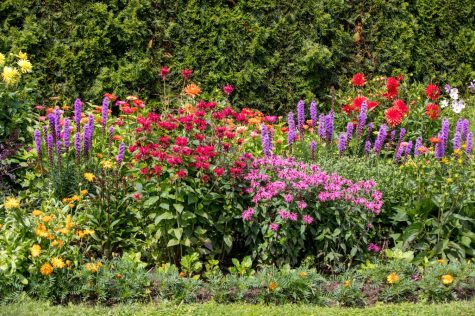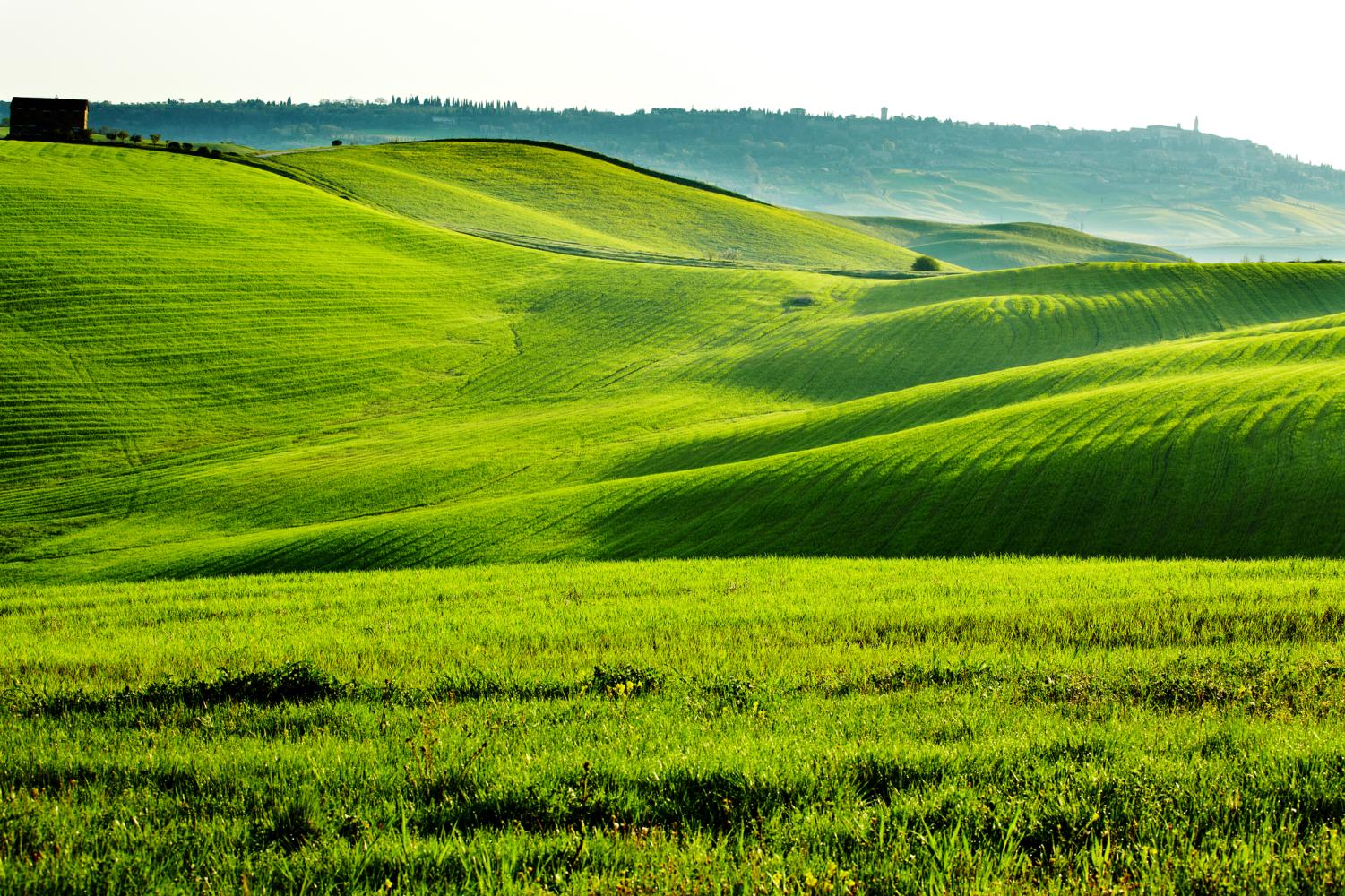Grass or Frass?
November 18, 2022
Have a go at this: what is the largest monocrop in the United States? Could it be corn, maybe wheat? How about apples or tomatoes? The answer lies right outside your door, beneath your feet, spreading as far as the eye can see. Green grass grows and blankets 40 million acres of the US alone. Brought over from Europe and known as “tall fescue,” the variety of grass so popular today for its aesthetic carpet-like quality is the ubiquitous choice for any lawn, park and developed area. This plant requires substantial irrigation, needing around an inch of water per week—big deal, right? Well, one inch of water across a single acre amounts to 27,152 gallons of water. The Environmental Protection Agency estimates a staggering 9 billion gallons of water are used by households for outdoor use alone on a daily basis, just to water the landscape.

On the other hand, our native plants—that is, plants indigenous to this area—hardly need watering at all once fully established. They are adapted to survive and thrive with respect to Maryland soil conditions and weather patterns, because they and their ancestral species have been here evolving under ecological pressures for thousands if not millions of years. As such, indigenous species are fine-tuned to all aspects of their natural environment and consequently do not need much of a human helping hand. Their flowers often bloom in brilliance, attracting a plethora of life and diversity with their showy petals and fragrant scents. Planting a yard or garden full of natives is like placing a gigantic biodiversity magnet in the neighborhood for birds, butterflies, squirrels and so much more. Our homes transform into habitat. What once was covered in a barren wasteland of thirsty grass instead becomes a vibrant, colorful, beautiful meadow, a restoration and reclamation of that which had been lost. The daily tally of outdoor water consumption shrinks to sustainable levels.
Maryland neighborhoods are pollutant channels connected to the Chesapeake Bay. Everybody with grass wants it green—really green. So, people hire lawn service companies to come to their homes and apply synthetic fertilizers to the grass. Nitrogen, the main component, tends to stick to water molecules when it rains. Rainwater washes nitrogenous fertilizer and applicated pesticidal remnants into the nearest waterbody or storm drain during weather events. This contaminated water is called runoff. From the waterbody—a stream for example—or the sewer, the water winds and weaves its way through coastal states and is either diverted through our faucets (we pull our tap water directly from streams and rivers!), enters into the body of an unfortunate marine organism or dumps right into the Chesapeake Bay or smaller reservoir. The application of synthetic fertilizers and pesticides to a lawn is kind of like having microdoses of chemicals added directly to the mix of water we drink, shower in, use to wash our dishes and clothes, etc. The watershed of the Bay, or, in other words, the total amount of land whose water ultimately dumps into the Chesapeake, is home to 18 million people and stretches across six states. Our lawns are inextricably connected to aquatic ecosystems, as are the chemical treatments that we pay to have sprayed.

Autumn is here and the leaves have fallen from the trees. A gorgeous spectrum of colors warms the eye as the air turns cold. Leaves with hues of reds, splashes and dashes of yellows and oranges, and wrinkled browns quietly detach and float to the ground. As the days shorten, Nature sews its annual patchwork quilt to prepare for the winter. A bumblebee queen burrows beneath the ground and nestles under her blanket of leaves to keep from freezing during the cold months ahead. She alone, the sole survivor of her brethren, will restart the colony come spring. Tucked away in the dark hole, the drowsy bee begins to drift to sleep. Suddenly, a scraping sound disrupts the silence. The darkness is disturbed, pierced by a pale sunlight. A chill creeps in. Inches above, a tall two-footed figure with a long, wired hand mechanically drags leaf after insulating leaf into piles and heaps. Nature’s blanket is being torn from the ground.
Few consider that leaves provide a critical source of habitat for a tremendous diversity of life. Swallowtail caterpillars, beautiful luna moths, bumblebees, spiders, beetles, snails and so much more overwinter in the leaves. Many of these organisms are a relied-upon food source for animals like birds, squirrels, frogs and foxes. The very cycle of life is disrupted on a yearly basis as neighborhoods collectively groom their lawns to maintain a manicured, aesthetically pleasing look. The price is paid by the silent deaths and discontinuations of future generations. New blooms of flowers in spring will dieback to the earth unfertilized, wondering at the inactivity and stillness of the air. Baby birds will go hungry as their mommy searches for caterpillars in vain. Pests will attack vegetables with vigor without spiders on guard nearby. And all the while, the lawn shines green.
Leaving the leaves ensures survival of these beneficial organisms in the environment, which will be there after winter to crack down on pests and provide for the health of the landscape. This relates to principles of Integrative Pest Management, which seeks to proactively prevent plant problems by making knowledgeable, wise choices that offer short-term and long-term benefits. By choosing not to rake, individuals convert their land into a living, breathing ecosystem. The tenants beneath the surface repay the debt by pollinating the flowers and feeding the birds come spring. The leaves themselves decompose over time, suppressing and smothering weeds in the process. Their microorganisms and nutrient-rich detritus work into the soil and revitalize plants, effectively acting as a completely natural, free mulch, courtesy of the trees. Chemical controls—pesticides, herbicides and fertilizers—need not be used. They can instead gather dust as nature takes its course.

Thick layers of leaves on tall fescue grasses do interfere with the fescue’s ability to photosynthesize. The leaves can create conditions favorable for fungal organisms, thus increasing the grass’s susceptibility to disease. Thus, there is a basis for raking in the fall other than aesthetics. If a homeowner insists on keeping tall fescue (or other types of turf grass) as the basis of the lawn, there are a wide range of compromises that can provide beauty, life and vitality to the landscape. For example, “leaf litter” habitats can be preserved by pushing leaves into garden beds to fertilize plants. Large piles of leaves can be gathered into dedicated spots, ensuring the preservation of camouflaged chrysalises. If replacing a lawn entirely with native plants is not an option, sections of the yard can be gradually converted to incorporate indigenous species. Even small changes such as these make a tangible difference and offer opportunities for life.
Grasses tend to involve significantly more upkeep, time and monetary investment than native plants, and incomparable quantities of synthetic chemicals. To maintain the green carpet look, grass is periodically and routinely mowed to short heights, burning gas and indiscriminately stifling and killing anything attempting to inhabit the area. What has become societally and culturally acceptable—to cover 40 million acres of our country in ecologically dead plant material—is the unspoken expectation of the homeowner. Current conventional practices place immense stress on shared global resources and the environment. Mounting climatic and environmental pressures—a dropping water supply, decline of pollinators, persistent chemicals in the environment—are going to force people to reevaluate their habits and values. We as landowners have the choice to play an active part in assisting with nature’s reclamation.
